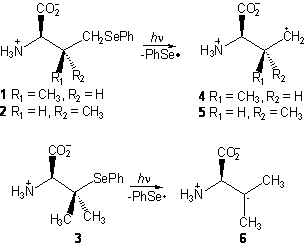
ACS PRF | ACS
All e-Annual Reports

43973-GB4
Using a Photolabile Precursor to Study Radical-Mediated Protein Damage
Free radical intermediates are implicated in the damage of polymeric molecules such as proteins. The objective of this research is to independently generate and characterize key radical intermediates involved in protein degradation and identify products resulting from this damage pathway. Aryl selenide-containing valine derivatives 1-3 (Figure 1) were designed as valine radical precursors. It is anticipated that these will undergo C-Se bond homolysis upon UV-irradiation to generate the corresponding amino acid radicals (4-6).

Figure 1. Aryl selenide precursors for amino acid radicals.
Brominated valine derivatives 7-9 (Figure 2) were chosen as intermediates in the synthesis of the radical precursors (1-3) and prepared by reported methods.1, 2 It was envisioned that upon treatment with a benzeneselenolate equivalent, these halides would afford protected radical precursors (10-12) which upon deprotection would afford the desired radical precursors (4-6).

Figure 2. Halogenated precursors for amino acid selenides.
Diastereomeric bromides 7 and 8 proved to be surprisingly unreactive toward a variety of standard methods for the generation of benzeneselenolate equivalents. For example, treatment with diphenyl diselenide and NaBH4 in ethanol resulted in recovery of starting material.3 In order to increase the reactivity of the starting material, 7 and 8 were converted to the corresponding iodides (13, 14, Figure 3).1 After exploring a variety of reaction conditions, treatment with diphenyl diselenide and NaH in DMF gave rise to diastereomeric selenides 10 and 11 as well as diastereomeric cyclopropanes (15 and 16, Figure 3). Purification of the reaction mixture has proven to be problematic and optimization of the reaction conditions to produce higher purity product is currently underway.

Figure 3. Reaction of primary iodides 13 and 14.
Tertiary selenide 9 also proved inert to a variety of benzeneselenolate equivalents. A recently reported method for preparing aryl selenides from tertiary alkyl halides using diphenyl diselenide in the presence of InI was also unsuccessful, giving rise to the elimination product (17) as well as alcohol 18. We are currently exploring the use of benzeneselenol in the presence of Lewis acids in order to circumvent this difficulty.4

Figure 4. Reaction of tertiary selenide 9 with benzeneselenolate equivalents.
References
1. “Stereoselective Synthesis of (2S, 3S)-g-Hydroxyvaline Utilising an Asymmetric Radical Hydrogen Bromide Addition,” Easton, C. J.; Merrett, M. C. Tetrahedron 1997, 53, 1151-1156.
2. “Synthesis of Homochiral Hydroxy a-Amino Acid Derivatives,” Easton, C. J.; Hutton, C. A.; Tan, E. W.; Tiekink, E. R. T. Tetrahedron Lett., 1990, 48, 7059-7062.
3. “A Mild Procedure for the Conversion of Epoxides to Allylic Alcohols. The First Organoselenium Reagent,” K. B. Sharpless; Lauer, R. F. J. Am. Chem. Soc. 1973, 95, 2697-2698.
4. “Novel Synthesis of Tertiary Alkyl, Secondary, and Tertiary Benzyl, and Allyl Selenides From the Corresponding Alcohols,” Clarembeau, M.; Krief, A. Tetrahedron Lett. 1984, 33, 3625-3628.